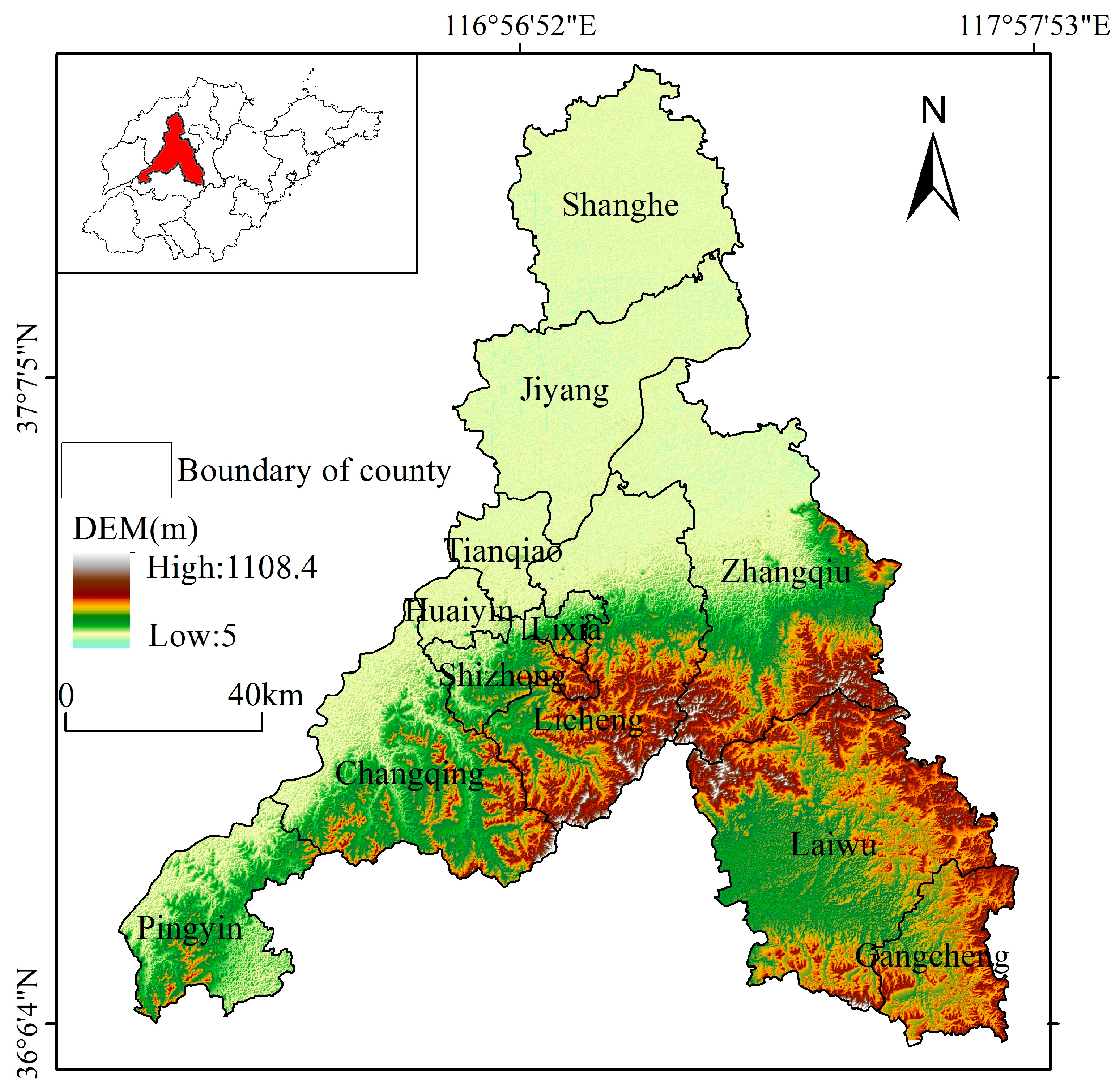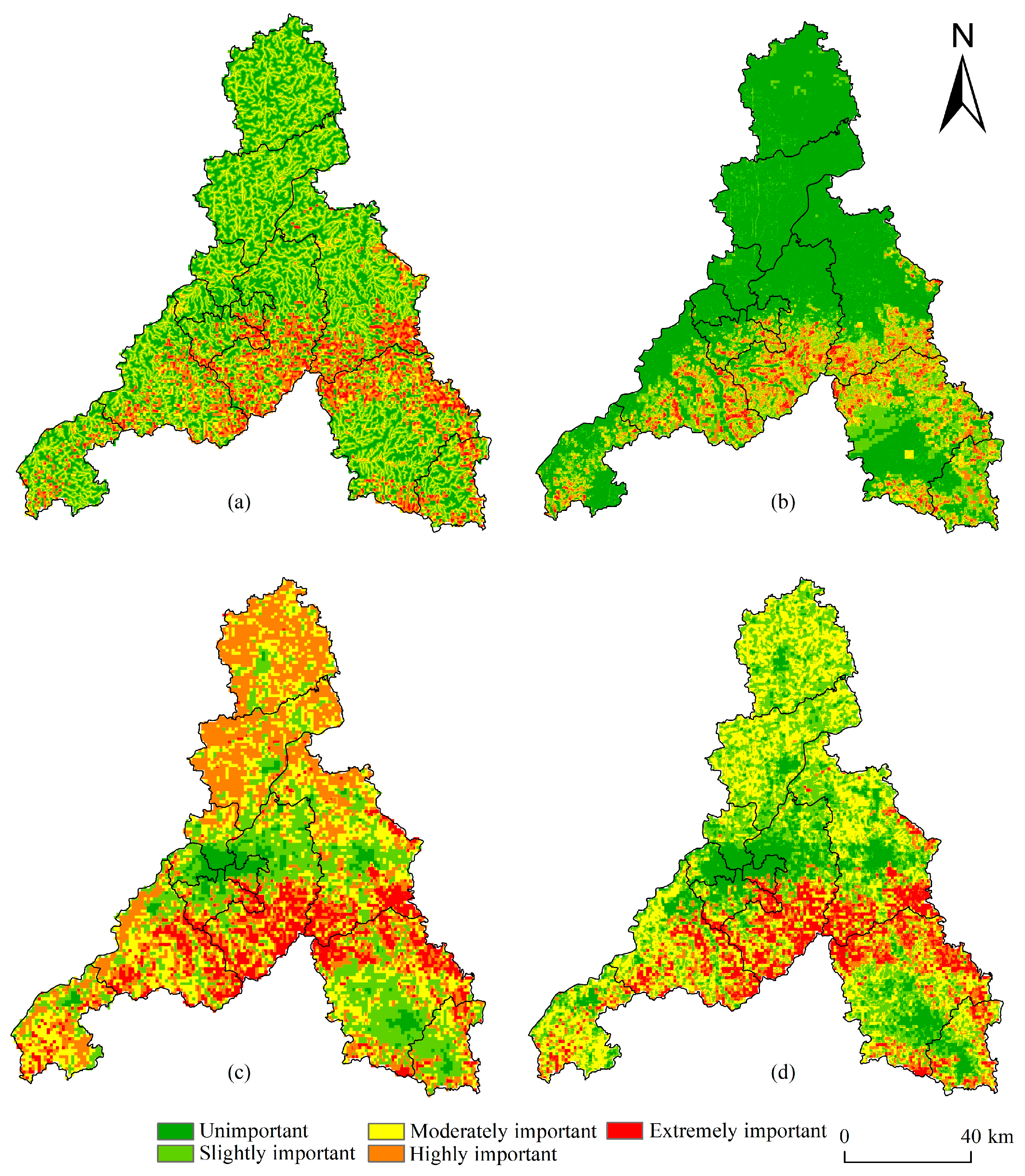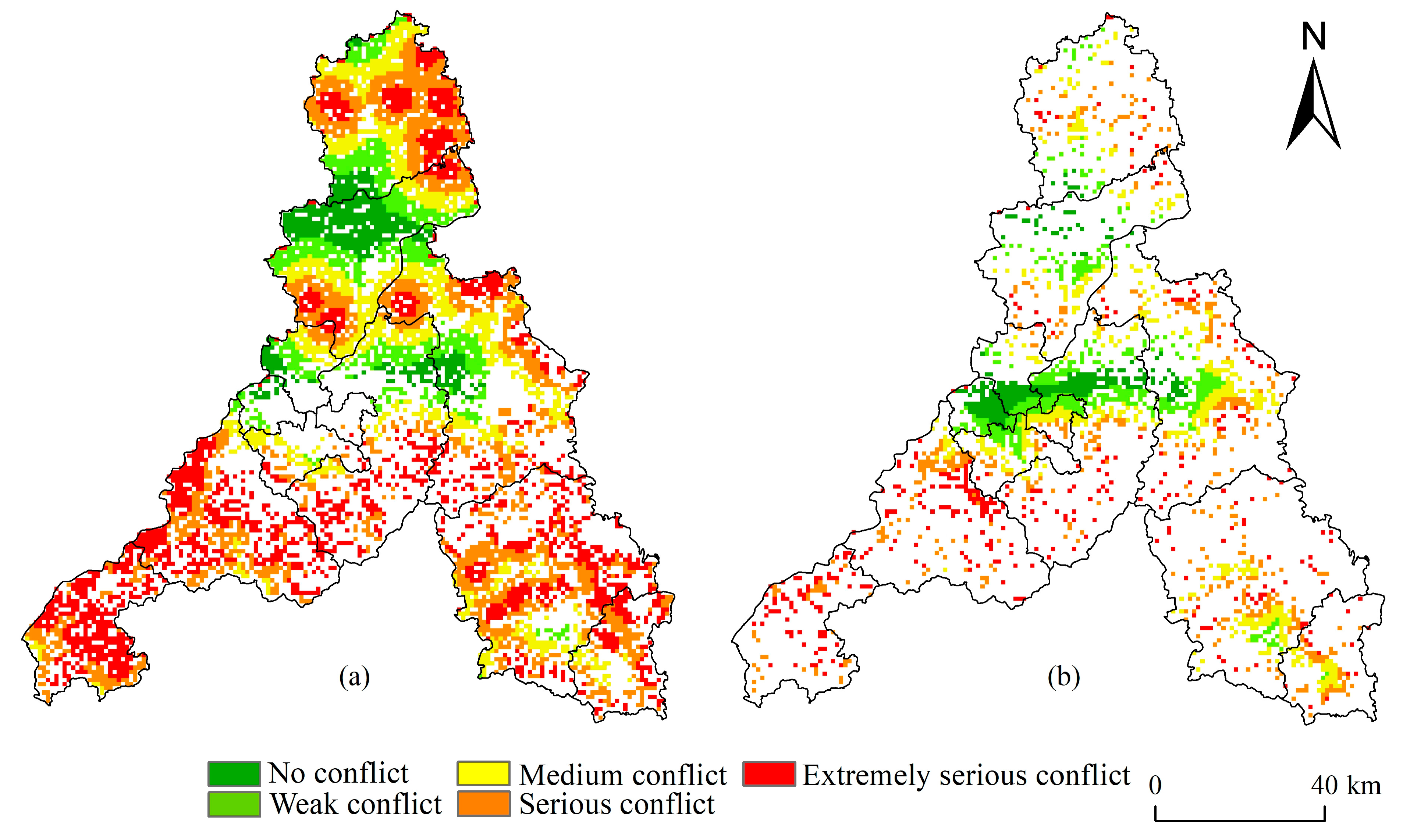Land Use Conflict Identification Coupled with Ecological Protection Priority in Jinan City, China
Abstract
1. Introduction
2. Study Area and Data Sources
2.1. Study Area
2.2. Data Sources
3. Methods
3.1. Evaluating the Importance of Ecosystem Service Functions
3.2. Ecological Sensitivity Evaluation
3.3. Deriving the Ecological Security Pattern
3.3.1. Ecological Source Identification
3.3.2. Establishment of Minimum Cumulative Resistance Surface
3.3.3. Extraction and Optimization of Ecological Corridor Network
3.3.4. Deriving the Ecological Security Pattern
3.4. Identification and Classification of Land Use Conflicts
4. Results
4.1. Spatial Distribution of the Importance of Ecosystem Service Functions
4.2. Spatial Distribution of Ecological Sensitivity
4.3. Ecological Security Pattern
4.4. Spatial Characteristics of Land Use Conflict
4.4.1. Conflict between Cultivated Land and Ecological Land
4.4.2. Conflict between Construction Land and Ecological Land
5. Discussion
5.1. Delineate Functional Zones and Formulate Differentiated Conflict Mediation Strategies
5.2. Limitations
6. Conclusions
Author Contributions
Funding
Institutional Review Board Statement
Informed Consent Statement
Data Availability Statement
Acknowledgments
Conflicts of Interest
References
- Von der Dunk, A.; Grêt-Regamey, A.; Dalang, T.; Hersperger, A.M. Defining a typology of peri-urban land-use conflicts—A case study from Switzerland. Landsc. Urban Plan. 2011, 101, 149–156. [Google Scholar] [CrossRef]
- Campbell, D.J.; Gichohi, H.; Mwangi, A.; Chege, L. Land use conflict in Kajiado District, Kenya. Land Use Pol. 2000, 17, 337–348. [Google Scholar] [CrossRef]
- Adam, Y.O.; Pretzsch, J.; Darr, D. Land use conflicts in central Sudan: Perception and local coping mechanisms. Land Use Pol. 2015, 42, 1–6. [Google Scholar] [CrossRef]
- Bax, V.; Francesconi, W.; Delgado, A. Land-use conflicts between biodiversity conservation and extractive industries in the Peruvian Andes. J. Environ. Manag. 2019, 232, 1028–1036. [Google Scholar] [CrossRef] [PubMed]
- Salhi, A.; Benabdelouahab, S.; Bouayad, E.O.; Benabdelouahab, T.; Larifi, I.; El Mousaoui, M.; Acharrat, N.; Himi, M.; Casas Ponsati, A. Impacts and social implications of landuse-environment conflicts in a typical Mediterranean watershed. Sci. Total Environ. 2021, 764, 142853. [Google Scholar] [CrossRef] [PubMed]
- Dadashpoor, H.; Ahani, S. Land tenure-related conflicts in peri-urban areas: A review. Land Use Pol. 2019, 85, 218–229. [Google Scholar] [CrossRef]
- Lin, Q.; Tan, S.; Zhang, L.; Wang, S.; Wei, C.; Li, Y. Conflicts of land expropriation in China during 2006–2016: An overview and its spatio-temporal characteristics. Land Use Pol. 2018, 76, 246–251. [Google Scholar] [CrossRef]
- Hui, E.C.M.; Bao, H. The logic behind conflicts in land acquisitions in contemporary China: A framework based upon game theory. Land Use Pol. 2013, 30, 373–380. [Google Scholar] [CrossRef]
- Zong, S.; Hu, Y.; Zhang, Y.; Wang, W. Identification of land use conflicts in China’s coastal zones: From the perspective of ecological security. Ocean Coast. Manag. 2021, 213, 105841. [Google Scholar] [CrossRef]
- Dietz, K.; Engels, B. Analysing land conflicts in times of global crises. Geoforum 2020, 111, 208–217. [Google Scholar] [CrossRef]
- Mugizi, F.M.P.; Matsumoto, T. From conflict to conflicts: War-induced displacement, land conflicts, and agricultural productivity in post-war Northern Uganda. Land Use Pol. 2021, 101, 105149. [Google Scholar] [CrossRef]
- Dong, G.; Ge, Y.; Jia, H.; Sun, C.; Pan, S. Land Use Multi-Suitability, Land Resource Scarcity and Diversity of Human Needs: A New Framework for Land Use Conflict Identification. Land 2021, 10, 1003. [Google Scholar] [CrossRef]
- Dong, G.; Liu, Z.; Niu, Y.; Jiang, W. Identification of Land Use Conflicts in Shandong Province from an Ecological Security Perspective. Land 2022, 11, 2196. [Google Scholar] [CrossRef]
- Valle, R.F.; Varandas, S.G.P.; Pacheco, F.A.L.; Pereira, V.R.; Santos, C.F.; Cortes, R.M.V.; Fernandes, L.F.S. Impacts of land use conflicts on riverine ecosystems. Land Use Pol. 2015, 43, 48–62. [Google Scholar] [CrossRef]
- Valle, R.F.; Varandas, S.G.P.; Fernandes, L.F.S.; Pacheco, F.A.L. Groundwater quality in rural watersheds with environmental land use conflicts. Sci. Total Environ. 2014, 493, 812–827. [Google Scholar] [CrossRef]
- Valera, C.A.; Valle Junior, R.F.; Varandas, S.G.P.; Sanches Fernandes, L.F.; Pacheco, F.A.L. The role of environmental land use conflicts in soil fertility: A study on the Uberaba River basin, Brazil. Sci. Total Environ. 2016, 562, 463–473. [Google Scholar] [CrossRef]
- Song, W.; Pijanowski, B.C.; Tayyebi, A. Urban expansion and its consumption of high-quality farmland in Beijing, China. Ecol. Indic. 2015, 54, 60–70. [Google Scholar] [CrossRef]
- Zhou, D.; Xu, J.; Lin, Z. Conflict or coordination? Assessing land use multi-functionalization using production-living-ecology analysis. Sci. Total Environ. 2017, 577, 136–147. [Google Scholar] [CrossRef]
- Kim, I.; Arnhold, S. Mapping environmental land use conflict potentials and ecosystem services in agricultural watersheds. Sci. Total Environ. 2018, 630, 827–838. [Google Scholar] [CrossRef]
- Jing, W.; Yu, K.; Wu, L.; Luo, P. Potential Land Use Conflict Identification Based on Improved Multi-Objective Suitability Evaluation. Remote Sens. 2021, 13, 2416. [Google Scholar] [CrossRef]
- Cao, J.; Cao, W.; Fang, X.; Ma, J.; Mok, D.; Xie, Y. The Identification and Driving Factor Analysis of Ecological-Economi Spatial Conflict in Nanjing Metropolitan Area Based on Remote Sensing Data. Remote Sens. 2022, 14, 5864. [Google Scholar] [CrossRef]
- Zhou, D.; Lin, Z.; Lim, S.H. Spatial characteristics and risk factor identification for land use spatial conflicts in a rapid urbanization region in China. Environ. Monit. Assess. 2019, 191, 677.1–677.22. [Google Scholar] [CrossRef]
- Jiang, S.; Meng, J.; Zhu, L.; Cheng, H. Spatial-temporal pattern of land use conflict in China and its multilevel driving mechanisms. Sci. Total Environ. 2021, 801, 149697. [Google Scholar] [CrossRef] [PubMed]
- Tudor, C.A.; Iojă, I.C.; Pǎtru-Stupariu, I.; Nită, M.R.; Hersperger, A.M. How successful is the resolution of land-use conflicts? A comparison of cases from Switzerland and Romania. Appl. Geogr. 2014, 47, 125–136. [Google Scholar] [CrossRef]
- Abubakari, M.; Twum, K.O.; Asokwah, G.A. From conflict to cooperation: The trajectories of large scale land investments on land conflict reversal in Ghana. Land Use Pol. 2020, 94, 104543. [Google Scholar] [CrossRef]
- Bao, W.; Yang, Y.; Zou, L. How to reconcile land use conflicts in mega urban agglomeration? A scenario-based study in the Beijing-Tianjin-Hebei region, China. J. Environ. Manag. 2021, 296, 113168. [Google Scholar] [CrossRef] [PubMed]
- Ma, W.Q.; Jiang, G.H.; Chen, Y.H.; Qu, Y.B.; Zhou, T.; Li, W.Q. How feasible is regional integration for reconciling land use conflicts across the urban-rural interface? Evidence from Beijing-Tianjin-Hebei metropolitan region in China. Land Use Pol. 2020, 92, 104433. [Google Scholar] [CrossRef]
- Liu, X.; Li, X.; Yang, J.; Fan, H.; Zhang, J.; Zhang, Y. How to resolve the conflicts of urban functional space in planning: A perspective of urban moderate boundary. Ecol. Indic. 2022, 144, 109495. [Google Scholar] [CrossRef]
- Qu, Y.; Wang, S.; Tian, Y.; Jiang, G.; Zhou, T.; Meng, L. Territorial spatial planning for regional high-quality development—An analytical framework for the identification, mediation and transmission of potential land utilization conflicts in the Yellow River Delta. Land Use Pol. 2023, 125, 106462. [Google Scholar]
- Karimi, A.; Brown, G. Assessing multiple approaches for modelling land-use conflict potential from participatory mapping data. Land Use Pol. 2017, 67, 253–267. [Google Scholar] [CrossRef]
- Brown, G.; Raymond, C.M. Methods for identifying land use conflict potential using participatory mapping. Landsc. Urban Plan. 2014, 122, 196–208. [Google Scholar] [CrossRef]
- Valle Junior, R.F.; Varandas, S.G.P.; Sanches Fernandes, L.F.; Pacheco, F.A.L. Environmental land use conflicts: A threat to soil conservation. Land Use Pol. 2014, 41, 172–185. [Google Scholar] [CrossRef]
- Cieślak, I. Identification of areas exposed to land use conflict with the use of multiple-criteria decision-making methods. Land Use Pol. 2019, 89, 104225. [Google Scholar] [CrossRef]
- Gao, Y.; Wang, J.; Zhang, M.; Li, S. Measurement and prediction of land use conflict in an opencast mining area. Resour. Policy 2021, 71, 101999. [Google Scholar] [CrossRef]
- Zou, L.; Liu, Y.; Wang, J.; Yang, Y.; Wang, Y. Land use conflict identification and sustainable development scenario simulation on China’s southeast coast. J. Clean. Prod. 2019, 238, 117899. [Google Scholar] [CrossRef]
- Jiang, S.; Meng, J.; Zhu, L. Spatial and temporal analyses of potential land use conflict under the constraints of water resources in the middle reaches of the Heihe River. Land Use Pol. 2020, 97, 104773. [Google Scholar] [CrossRef]
- Wang, W.; Li, B.Y.; Ren, Z.Y. Ecosystem service function evaluation: A case study of the yinchuan basin in China. Ecol. Eng. 2017, 106, 333–339. [Google Scholar] [CrossRef]
- Zhang, L.; Fang, C.; Zhu, C.; Gao, Q. Ecosystem service trade-offs and identification of eco-optimal regions in urban agglomerations in arid regions of China. J. Clean. Prod. 2022, 373, 133823. [Google Scholar] [CrossRef]
- Bozali, N. Assessment of the soil protection function of forest ecosystems using GIS-based Multi-Criteria Decision Analysis: A case study in Adıyaman, Turkey. Glob. Ecol. Conserv. 2020, 24, e01271. [Google Scholar] [CrossRef]
- Wang, Y.; Qu, Z.; Zhong, Q.; Zhang, Q.; Zhang, L.; Zhang, R.; Yi, Y.; Zhang, G.; Li, X.; Liu, J. Delimitation of ecological corridors in a highly urbanizing region based on circuit theory and MSPA. Ecol. Indic. 2022, 142, 109258. [Google Scholar] [CrossRef]
- Hou, Q.; Du, Y.; Dong, W.; Zeng, Z.; Zhang, L.; Duan, Y.; Hou, X. Smart city oriented ecological corridor layout of Sanshui River Basin in arid area of Loess Plateau. Sustain. Energy Technol. Assess. 2021, 44, 100993. [Google Scholar] [CrossRef]
- Li, P.; Cao, H.; Sun, W.; Chen, X. Quantitative evaluation of the rebuilding costs of ecological corridors in a highly urbanized city: The perspective of land use adjustment. Ecol. Indic. 2022, 141, 109130. [Google Scholar] [CrossRef]
- Fu, Y.; Shi, X.; He, J.; Yuan, Y.; Qu, L. Identification and optimization strategy of county ecological security pattern: A case study in the Loess Plateau, China. Ecol. Indic. 2020, 112, 106030. [Google Scholar] [CrossRef]
- Jiang, H.; Peng, J.; Zhao, Y.; Xu, D.; Dong, J. Zoning for ecosystem restoration based on ecological network in mountainous region. Ecol. Indic. 2022, 142, 109138. [Google Scholar] [CrossRef]
- Li, S.; Zhu, C.; Lin, Y.; Dong, B.; Chen, B.; Si, B.; Li, Y.; Deng, X.; Gan, M.; Zhang, J.; et al. Conflicts between agricultural and ecological functions and their driving mechanisms in agroforestry ecotone areas from the perspective of land use functions. J. Clean. Prod. 2021, 317, 128453. [Google Scholar] [CrossRef]
- Li, Z.; Liu, Y.; Zeng, H. Application of the MaxEnt model in improving the accuracy of ecological red line identification: A case study of Zhanjiang, China. Ecol. Indic. 2022, 137, 108767. [Google Scholar] [CrossRef]





| Ecosystem Service Function | Indicators | Weights | Indicator Grading and Score | ||||
|---|---|---|---|---|---|---|---|
| 1 | 3 | 5 | 7 | 9 | |||
| Headwater conservation | Distance from river (m) | 0.11 | >500 | 200~500 | 100~200 | 50~100 | <50 |
| Land cover | 0.18 | Other, swamp | Temperate grass, meadow | A deciduous orchard | Coniferous forest | Deciduous thicket, deciduous broadleaved forest | |
| Water and soil conservation | Soil erosion intensity | 0.13 | No erosion | Mild erosion | Moderate erosion | Intensity erosion | Extreme erosion |
| Topographic relief (m) | 0.1 | 0~6 | 6~15 | 15~26 | 26~39 | >39 | |
| Soil texture | 0.08 | Stony soil | Coarse bone soil, sandy soil | Alluvial soil, tidal soil | Brown soil, clay, black soil | Brown soil | |
| Biodiversity protection | Land use type | 0.19 | Construction land | Cultivated land, unused land | Water area | Grassland | Forest land |
| Vegetation coverage (%) | 0.21 | <25 | 25~50 | 50~70 | 70~85 | >85 | |
| Ecological Sensitivity | Indicators | Weights | Indicator Grading and Score | ||||
|---|---|---|---|---|---|---|---|
| 1 | 3 | 5 | 7 | 9 | |||
| Soil erosion | Soil type | 0.15 | Paddy soil, lake, river | Stony soil, sandy soil, coarse bone soil, salt soil | Cinnamon soil | Brown soil, clay, alluvial soil | Black soil, tidal soil |
| Rainfall erosivity (MJ·mm/[hm2·h]) | 0.12 | 2367~2842 | 2842~3361 | 3361~3922 | 3922~4542 | 4542~6040 | |
| Vegetation type | 0.16 | Deciduous orchard, swamp | Temperate grass, meadow | Deciduous shrub | Coniferous forest | Deciduous broadleaf forest | |
| Slope (°) | 0.12 | <5 | 5~10 | 10~15 | 15~25 | >25 | |
| Biodiversity | Vegetation coverage (°) | 0.14 | <25 | 25~50 | 50~70 | 70~85 | >85 |
| Biological abundance index | 0.16 | <20 | 20~35 | 35~55 | 55~75 | >75 | |
| Geological hazard | Areas prone to geological disasters | 0.15 | Non-prone area | Low-prone area | Medium-prone area | — | Highly prone area |
| Resistance Factors | Weights | Index Grading and Score | ||||
|---|---|---|---|---|---|---|
| 1 | 3 | 5 | 7 | 9 | ||
| Elevation (m) | 0.19 | <90 | 90~215 | 215~340 | 340~494 | >494 |
| Slope (°) | 0.17 | <5 | 5~10 | 10~15 | 15~25 | >25 |
| Land use type | 0.18 | Forest land | Grassland | Water area | Cultivated land, unused land | Construction land |
| Vegetation coverage (%) | 0.14 | >85 | 70~85 | 0.50~0.70 | 25~50 | <25 |
| Distance to settlement (km) | 0.17 | >2 | 1~2 | 0.5~1 | 0.25~0.5 | <0.25 |
| Distance to road (km) | 0.15 | >5 | 2~5 | 1~2 | 0.5~1 | <0.5 |
| Land Use Type | Ecological Security Grade | Degree of Conflict |
|---|---|---|
| Cultivated land or construction land | Extreme insecurity | Extremely serious conflict |
| Cultivated land or construction land | Relative insecurity | Serious conflict |
| Cultivated land or construction land | Security | Medium conflict |
| Cultivated land or construction land | Relative security | Weak conflict |
| Cultivated land or construction land | Extreme security | No conflict |
Disclaimer/Publisher’s Note: The statements, opinions and data contained in all publications are solely those of the individual author(s) and contributor(s) and not of MDPI and/or the editor(s). MDPI and/or the editor(s) disclaim responsibility for any injury to people or property resulting from any ideas, methods, instructions or products referred to in the content. |
© 2023 by the authors. Licensee MDPI, Basel, Switzerland. This article is an open access article distributed under the terms and conditions of the Creative Commons Attribution (CC BY) license (https://creativecommons.org/licenses/by/4.0/).
Share and Cite
Dong, G.; Wang, J.; Zhang, W.; Liu, Z.; Wang, K.; Cheng, W. Land Use Conflict Identification Coupled with Ecological Protection Priority in Jinan City, China. Int. J. Environ. Res. Public Health 2023, 20, 4863. https://doi.org/10.3390/ijerph20064863
Dong G, Wang J, Zhang W, Liu Z, Wang K, Cheng W. Land Use Conflict Identification Coupled with Ecological Protection Priority in Jinan City, China. International Journal of Environmental Research and Public Health. 2023; 20(6):4863. https://doi.org/10.3390/ijerph20064863
Chicago/Turabian StyleDong, Guanglong, Jue Wang, Wenxin Zhang, Zheng Liu, Kehua Wang, and Weiya Cheng. 2023. "Land Use Conflict Identification Coupled with Ecological Protection Priority in Jinan City, China" International Journal of Environmental Research and Public Health 20, no. 6: 4863. https://doi.org/10.3390/ijerph20064863
APA StyleDong, G., Wang, J., Zhang, W., Liu, Z., Wang, K., & Cheng, W. (2023). Land Use Conflict Identification Coupled with Ecological Protection Priority in Jinan City, China. International Journal of Environmental Research and Public Health, 20(6), 4863. https://doi.org/10.3390/ijerph20064863






